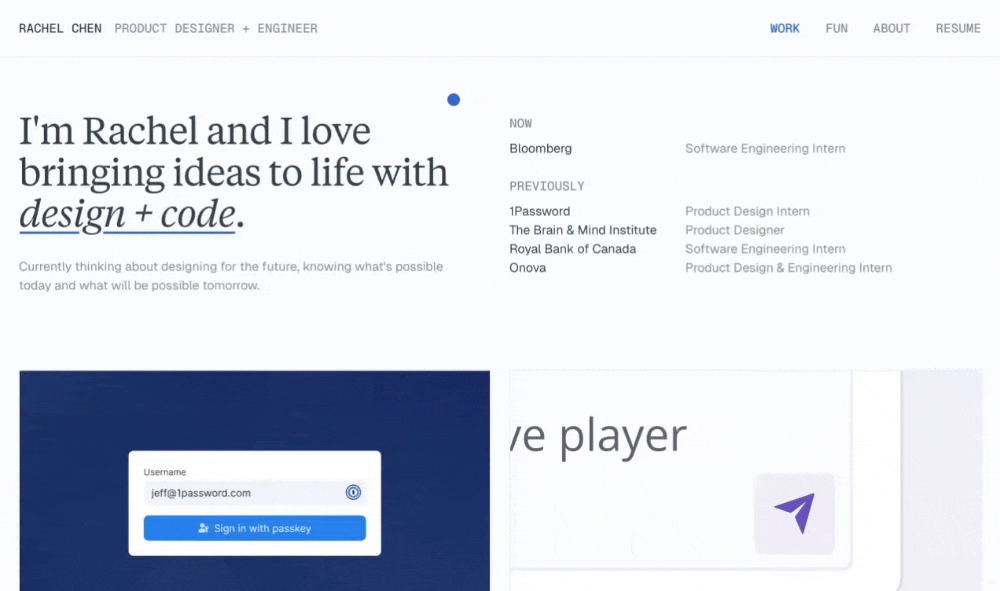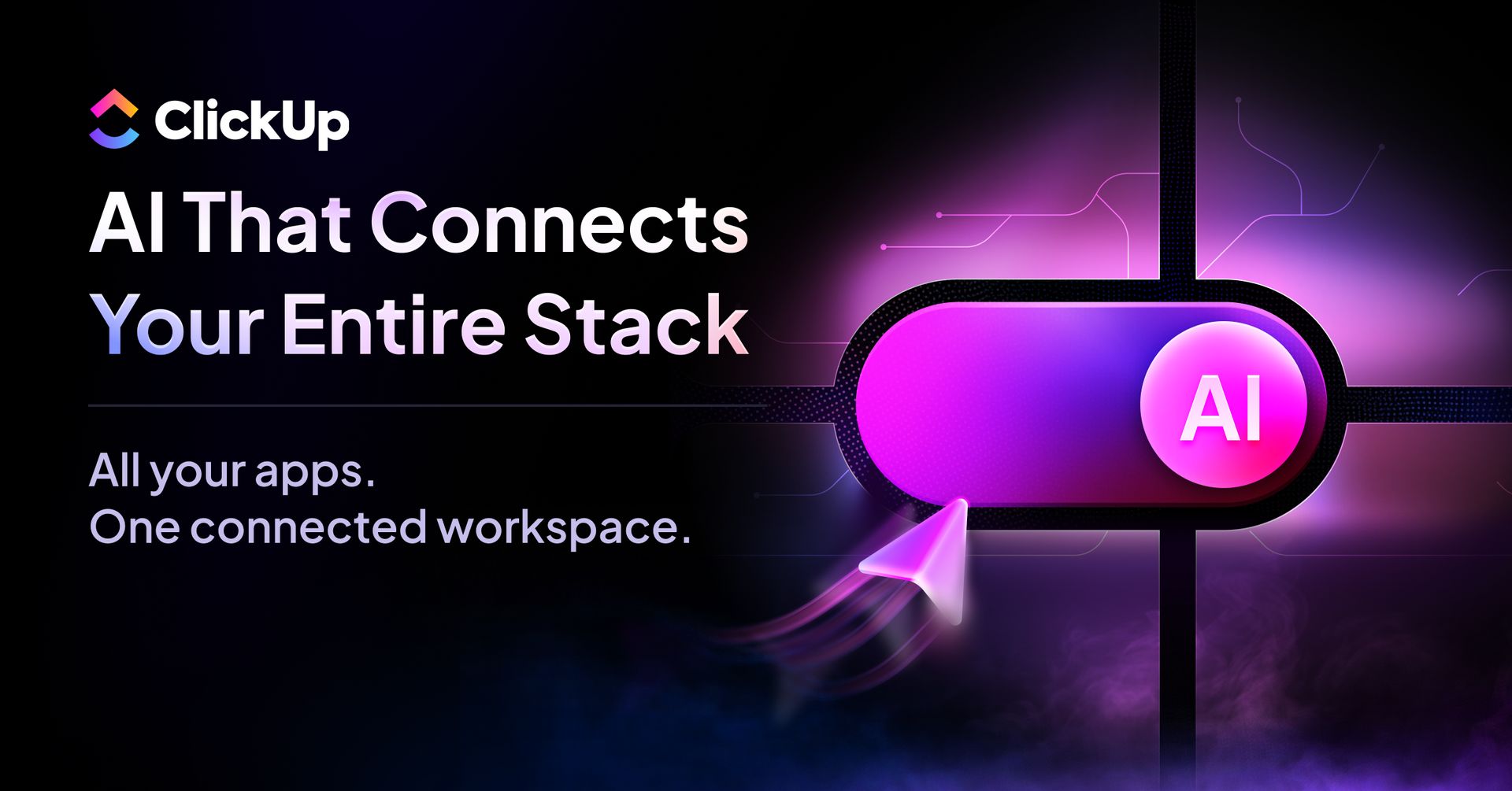- Open Doors
- Posts
- The Ultimate Resume Guide for Designers in 2025 📄
The Ultimate Resume Guide for Designers in 2025 📄
How to stop overthinking and start building a resume that actually works

Hey and welcome back to another week! 👋
In this issue:
Everything You Need To Know About Resumes: I wish they weren’t but they are still relevant.
Rachel’s Portfolio: Experience a unique and awesome blend of engineering and design skills.
🤝 TODAY’S PARTNER
The Only AI That Knows All Your Work
Most AI tools start from scratch every time. ClickUp Brain already knows the answers.
It has full context of all your work—docs, tasks, chats, files, and more. No uploading. No explaining. No repetitive prompting.
ClickUp Brain creates tasks for your projects, writes updates in your voice, and answers questions with your team's institutional knowledge built in.
It's not just another AI tool. It's the first AI that actually understands your workflow because it lives where your work happens.
Join 150,000+ teams and save 1 day per week.
The Ultimate Resume Guide for Designers in 2025 📄

In 2025, designers still need resumes — but probably not in the way you’ve been told.
If you’re applying for design jobs this year, chances are you’ve already asked yourself:
Do resumes even matter anymore?
What if I only focus on my portfolio?
Do I need to optimize for ATS?
The reality is that resumes won’t get you the job — your work will. But they still open the door. If no one gets to your portfolio, no one gets to your work. This guide will walk you through how to build a designer resume that actually helps you land interviews without spending hours obsessing over formatting, keywords, or templates that look good on Pinterest but fall apart in real life.
I already gave useful tips on how to spice up your resume before but this time I’m looking at the absolute foundations that will already get you somewhere.
1. Resumes still matter (but not in the way you think)
Even in 2025, most design job applications still start with two documents: your portfolio and your resume. Sometimes a cover letter too, but that’s becoming less common and often optional. And while your portfolio is the real star of the show, your resume is often the first document that gets looked at — or scanned — by humans or software.
I’ve seen this happen many times: early-career designers get ghosted not because their work is bad, but because their resumes aren’t doing the minimum job of getting someone to click through to their portfolio. It’s not a glamorous document, but it’s a crucial one.
Think of your resume as the packaging around your portfolio. If the packaging is confusing, unreadable, or just unappealing, your work won’t get seen.
2. The truth about ATS (and why you shouldn’t panic)
ATS (Applicant Tracking System) optimisation has become a bit of a resume myth machine.
Yes, companies use HR tools that scan and sometimes summarise your resume. But no, this doesn’t mean that if your resume isn’t “ATS compliant” to the letter, you’re getting auto-rejected. The reality:
ATS systems do extract text and sometimes generate summaries of your resume using OCR and AI.
They don’t automatically reject you if they can’t parse it perfectly — recruiters still review applications manually.
Most rejections happen because of poor formatting, unreadable text, or not linking your portfolio, not because of some magical ATS score.
If you want your resume to be parsed properly, choose a tool that exports clean PDFs with selectable text and embedded fonts. Google Docs and Word are safe bets. Canva can work too, but keep the layout simple. Avoid Figma for resumes — its PDF export often doesn’t embed fonts correctly and can garble text.
Tables are another problem. Even if you never insert a table, some tools will automatically convert a two-column layout into one on export, which can break parsing. Stick to single-column layouts for maximum safety.
If you want, you can keep two versions of your resume: one safe, clean version for job portals, and one more styled version to send directly to people. But for most people, one clean, well-structured resume is enough.
3. The essential resume layout for designers
A good designer resume doesn’t need much. Here’s the core structure:
Your name and contact info — including your email, LinkedIn, and a portfolio link. This link is crucial. In analytics I’ve run with mentees, a large portion of portfolio traffic comes directly from resumes.
Summary — a short paragraph on what kind of designer you are and what roles you’re aiming for.
Skills — only the skills relevant to the jobs you want. You can identify these by pasting several job descriptions into a tool like ChatGPT and asking it to extract common skills.
Experience — roles, responsibilities, and most importantly, impact.
Education — short and relevant, including bootcamps where applicable.
Cut the fluff. Avoid hobbies unless they’re directly relevant. Avoid weak side projects or filler. Avoid long lists of generic soft skills with no context.
4. How to tailor your resume without rewriting it every time
Tailoring your resume for each job is worth doing, but you don’t need to rewrite it every time.
Start with a “master template” — one long document with every skill, bullet point, and piece of experience you might want to use. It will be far too long to send to anyone, and that’s fine.
When applying for a job, duplicate the master and delete everything that isn’t relevant to that role. If you have both B2B and B2C experience and the job is B2B, remove the B2C-heavy points. Focus on the skills and results the role is looking for, cutting weaker or less relevant points until you have a focused one-page document.
With this approach, tailoring takes five to ten minutes at most. You can even feed the job description and your master resume into AI tools to get recommendations on what to keep and remove.
5. Writing bullet points that work
Bullet points are the most important part of your resume, and most designers get them wrong. Listing only tasks or responsibilities (“Designed landing pages”, “Worked with devs”) won’t cut it. You need to show impact.
A useful way to structure them is the Google XYZ formula:
Accomplished X, as measured by Y, by doing Z.
Instead of:
Created wireframes for a new dashboard.
Write:
Reduced user churn by 15% by designing a simplified dashboard experience based on user testing insights.
Not every project will have metrics, but you should always aim to be specific and outcome-driven. Show what changed because of your work.
Bonus: Make your resume reflect the roles you want
Your resume should tell the same story as your portfolio: what kind of designer you are, and what kind of roles you want next. Aiming for B2B SaaS? Highlight different experience than if you’re targeting consumer-facing mobile apps.
Look at how designers in different industries present themselves. A product designer at Instagram will highlight different work than one at IBM. Learn to spot those differences, and shape your own resume accordingly.
TL;DR
Resumes are still relevant, but their job is to get people to your portfolio.
Don’t over-optimise for ATS — just make sure your PDF is clean and machine-readable.
Use a safe tool like Google Docs or Word. Avoid tables and complex layouts.
Include your portfolio link (+ password if applicable). Always.
Stick to essential sections: summary, skills, experience, education.
Build a master template and trim it for each job.
Write bullet points that show impact, not just activity.
Let your resume support the story of the designer you want to be.
In the end, a resume is not about ticking boxes or gaming systems. It’s about removing friction between your application and the person reviewing it, so they can get to the work that will actually convince them to hire you.
👀 Portfolio Showcase

Today: Rachel Chen
Rachel Chen’s portfolio blends design craft and engineering precision into one seamless story.
A rare combination of storytelling, motion, and technical depth — from a designer who’s also a full-fledged software engineer.
Rachel isn’t just “a designer who can code.” She’s a real engineer with experience in AI, machine learning, and complex software systems — all while building thoughtful, visually polished design work. Her internships span both worlds: product design at 1Password, software engineering at the Royal Bank of Canada, and now Bloomberg.
She’s still a student, but her portfolio already sits in that coveted design–engineering niche. And crucially, she doesn’t compromise: the craft is there in every detail, and the presentation is as considered as the work itself.
Let’s look at what makes it so strong — and a couple of areas where it could go even further.
That’s it for this week—thanks so much for the support! ♥️
If you’d like to support my efforts on Open Doors further you can buy me a coffee. If you ever got any value from my emails consider it so I can keep this newsletter free and available to everyone out there.
Do you want your own portfolio reviewed in-depth with a 30-minute advice-packed video review? Or do you require mentoring to figure out a proper strategy for your job search?
I got you!
Book a mentoring session with me
Book a quick 15 min chat to ask a question and see if we vibe
Keep kicking doors open and see you next week!
- Florian


